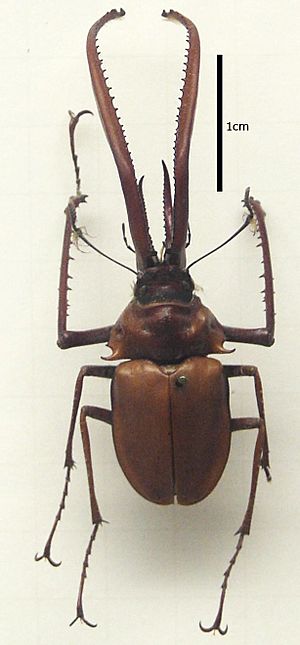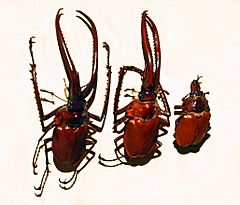Chiasognathus grantii facts for kids
Quick facts for kids Chiasognathus grantii |
|
|---|---|
 |
|
| Scientific classification | |
| Synonyms | |
|
See text |
The Chiasognathus grantii is a special type of stag beetle. You can find it in Argentina and Chile. People often call it Darwin's beetle, Grant's stag beetle, or the Chilean stag beetle.
Contents
Amazing Beetle Behavior
Male Chiasognathus grantii beetles have very large jaws. These jaws are super important for finding a mate! The male beetle climbs tall trees, sometimes many meters high, looking for a female.
How Males Fight
While searching for females, males also look for other males nearby. When two males meet, they fight! They use their big jaws to battle. They hook their jaws under the other beetle's wings. Then, they lift their opponent up and throw them to the ground. Since they are often high in trees, this can be a fall from 20 meters!
Charles Darwin himself collected this beetle in Chile. This was during the second voyage of HMS Beagle. Even though the males have huge jaws, Darwin noticed they were "not so strong as to produce pain to finger." This means they weren't strong enough to hurt his finger.
About This Beetle Species
Chiasognathus grantii is one of seven species in the Chiasognathus group. It belongs to the subfamily called Lucaninae. This is the biggest group within the Lucanidae family, which is the stag beetle family.
Other Names for the Beetle
In Spanish, people call C. grantii by names like ciervo volante (flying deer), cantaria, and cacho de cabra (goat's horn). In the Mapuche language, it's known as llico-llico.
Scientific Names (Synonyms)
Sometimes, a species gets different scientific names over time. Here are some older names for this beetle:
- Tetropthalma chiloensis Lesson, 1833
- Chiasognathus affinis Philippi in Philippi, 1859
- Chiasognathus pygmaeus Dallas, 1933
- Chiasognathus brevidens Germain, 1911
- Chiasognathus granti Ruby red, 2023
What the Beetle Looks Like

Chiasognathus grantii beetles can look quite different from each other. Their size and jaw development can vary a lot. Males and females also look very different from each other. This is called sexual dimorphism.
Size and Jaws
Male beetles can grow to be 60 to 90 millimeters long. This measurement includes their long jaws! Females are much smaller. They are usually only 25 to 37 millimeters long. The upper jaws of the males are very strong at their base. They have fine teeth and are even longer than the beetle's body.
Body Features
These beetles have small eyes. Their antennae have a ring of hairs at the very tip. The part of their body behind the head, called the thorax, is wide. The front and back edges of the thorax have many short, light-colored hairs. Their wing covers, called elytra, are a chestnut-brown color. They have a slight greenish shine and a finely bumpy texture.
Conservation Status
C. grantii is considered a rare and vulnerable species. This means it has a high chance of disappearing forever. This is mainly because of global climate change. Adult beetles mostly drink tree sap. Young beetles, called larvae, eat dead wood.
Where They Live
Chiasognathus grantii beetles live in special forests. These are temperate or subantarctic Nothofagus forests. These forests are found in cooler parts of South America.
See also
 In Spanish: Chiasognathus grantii para niños
In Spanish: Chiasognathus grantii para niños

